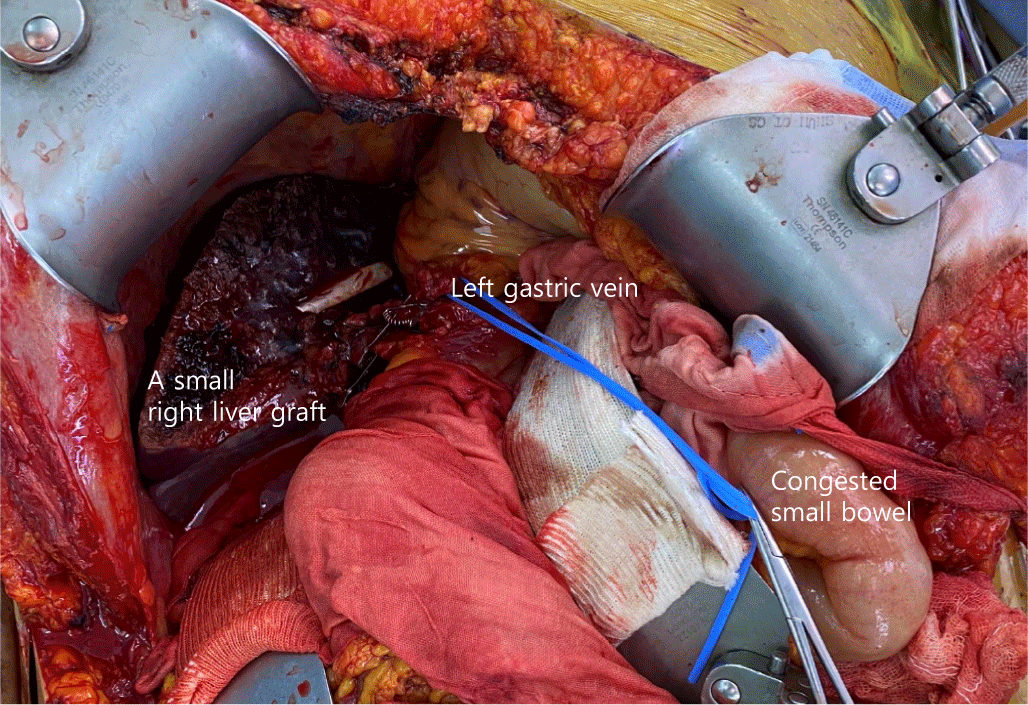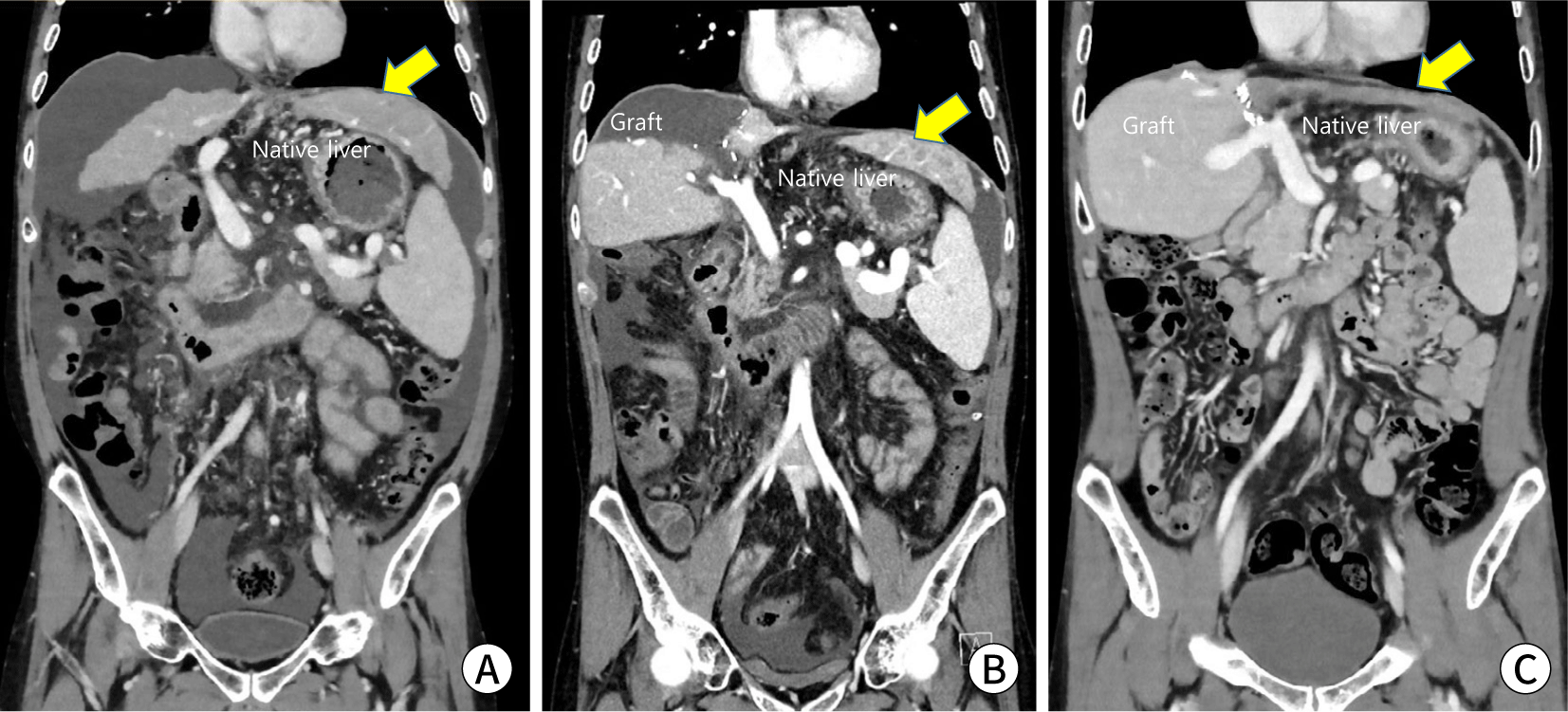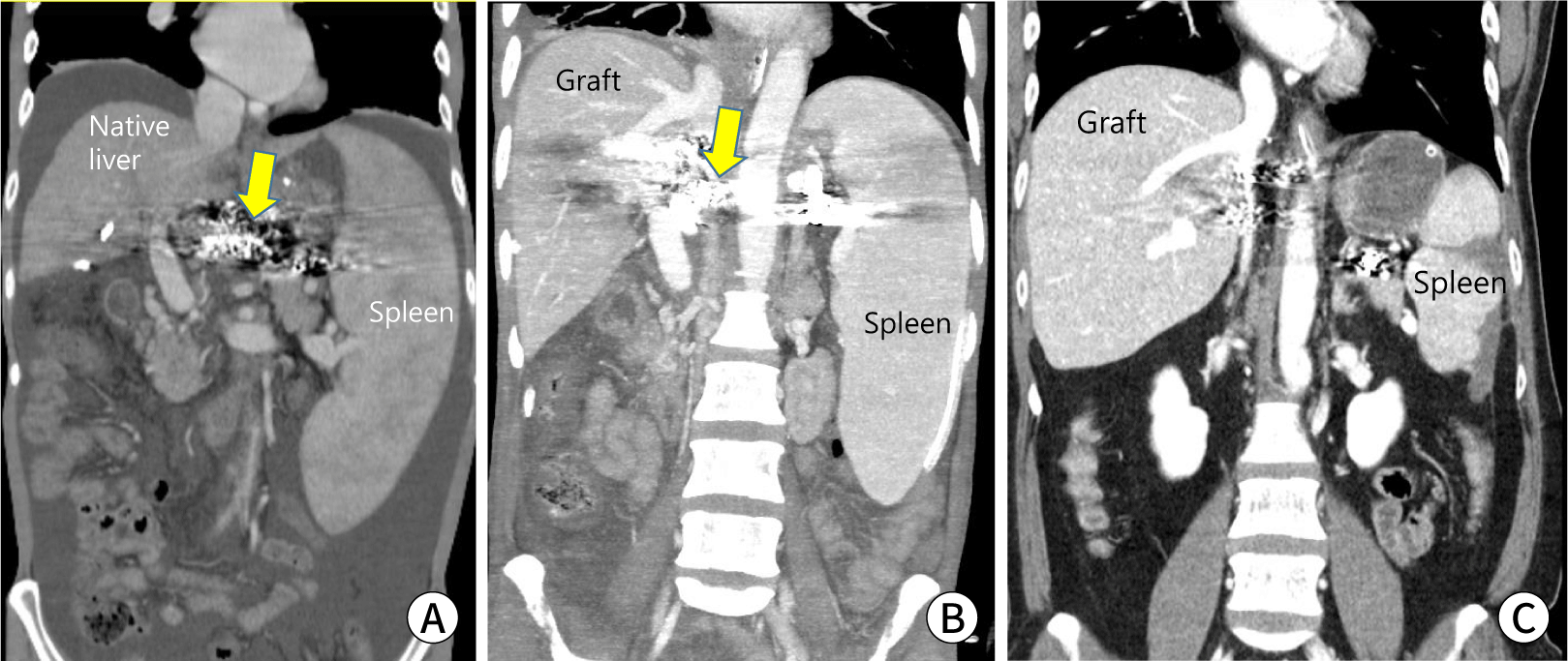Introduction
Liver transplantation (LT) is a definite and ultimate treatment alternative for end-stage and metabolic liver diseases [1-3]. Donor shortages push the boundaries of marginal donors in deceased donor liver transplantation and living donors worldwide. In living donor liver transplantation (LDLT), the safety of both recipients and donors is in line [4].
Definitions of Small for Size Syndrome
Small-for-size syndrome (SFSS) is a critical complication of LT using a partial graft, particularly in cases of adult-to-adult ALDLT using a small graft (Fig. 1). In general, small-for-size graft (SFSG) corresponds to a graft weight <0.8% of recipient weight or a graft volume <40% of recipient’s standard liver volume (SLV) [5-8]. Recent progress in perioperative care and technical improvement in partial LT, minimally required liver graft volume for successful transplantation is an ongoing debate and has decreased to 0.6% graft versus recipient weight ratio (GRWR) (approximately 25% of the recipient’s SLV).

The definition of SFSS varies among transplant centers. Persistent portal hypertension and hyperperfusion after SFSG transplantation have been identified as the main factors in this clinical syndrome [9,10]. Nevertheless, the SFSS is a multifaceted event. Typical clinical manifestations of SFSS are consequences of portal hypertension and graft dysfunction, presenting as more than two of the following on 3 consecutive days: (1) long-standing uncontrolled ascites (>1 L/day), (2) hyperbilirubinemia (total bilirubin >5 mg/dL), (3) coagulopathy (International normalized ratio >2), and (4) encephalopathy (≥grade 3) during the first postoperative week after transplantation and after the exclusion of other causes, such as vascular or biliary complications or rejection. Other symptoms or signs of portal hypertension can also be addressed. These manifestations can disappear or improve compared with the pre-transplantation status after graft functioning.
The factors associated with SFSS include preoperative patient condition, the natural development of varices, medical or surgical efforts to reduce portal pressure, no pressure gradient between the hepatic vein and inferior vena cava (or right atrium), graft quality, and graft size.
Small for Size Syndrome Pathophysiology
The main pathophysiology of SFSS is shear stress, which leads to sinusoidal microcirculatory disturbances caused by excessive portal pressure [11]. In the case of a small graft, repair and regeneration cannot overcome the damage and maintain liver function very early after transplantation. If this damage is permanent or severe, the outcome of SFSS is poor, leading to graft failure and patient death.
The early microscopic features of SFSS are ischemia related to arterial vasospasm and/or thrombosis and render hepato-cytes vulnerable to the subsequent oxidative stress leading to endothelial damage, cholestasis, hepatocyte ballooning, and ductular reaction, as well as bile duct necrosis. The late features include nodular regenerative hyperplasia [8,12,13].
Outcomes of Small for Size Syndrome
Early reports on SFSS demonstrated poor patient and graft survival outcomes. Patients with both elevated portal pressure (≥20 [range 18-25] mmHg) and SFSG (≤0.8% GRWR) showed significantly worse survival outcomes, bacteremia, and longer hospital stays. If the pre-transplant patient’s condition is worse, such as old age and high model for end-stage liver disease (MELD) score, post-transplant outcomes would be much worse [5,8,11,14].
Recent reports regarding the outcomes of SFSG have shown promising results (Table 1). Small grafts are associated with poor short-term outcomes. However, the long-term outcome was not inferior in patients with small grafts [15]. Therefore, prevention, early detection, and interventions to attenuate SFSS are important. Various approaches have been explored to modulate inflow and pressure to a small graft and to decrease the outflow block to alleviate this SFSS. Along with these efforts, strict matching criteria for patient and donor pairs are also important.
Prevention and Management to Improve the Outcome of Small for Size Graft
The management goal of the SFSS is to avoid SFSS. SFSS does not always occur in patients with SFSG. This can be prevented by cautiously matching the donor and recipient and applying surgical or medical modifications. Prevention of damage-related SFSG on portal hypertension is an ideal solution [8,16].
The principles for avoiding SFSS are as follows: First, it does not consider multiple risks of SFSS at once. There are several known factors related to SFSS: aged donor, graft steatosis, longer ischemic time, left small liver than right small liver, and recipient with a high MELD score [8,14,16]. For example, if the patient’s condition is poor, sufficient graft volume from a young donor with a short ischemic time rather than a small left liver graft is a better alternative [11,14,17].
Second, portal pressure is attenuated after accurate measurement of portal pressure during transplantation [14,16,17-20]. Several surgical procedures can reduce the portal pressure and alleviate potential SFSS. Remaining natural varices or creating transient portosystemic shunts can reduce portal hypertension during the early period of graft regeneration. However, portal steal syndrome can sometimes ruin sufficient inflow to the graft. Accurate measurement of portal pressure and flow via the inferior mesenteric vein or the direct portal puncture technique helps decide whether to proceed with these procedures [18]. After regeneration of a small graft, surgical or interventional shunt occlusion can be performed to improve the long-term graft outcomes and prevent variceal complications. An indirect method to reduce portal pressure is to reduce splenic venous inflow to the portal vein. Splenomegaly and splenic artery hypertrophy are common in patients with end-stage liver disease and portal hypertension. In that case, splenectomy, splenic artery ligation, or splenic devascularization can reduce portal pressure [9,16,21,22].
Third, we used the entire transplanted graft without ischemia or congestion, as possible [9,23,24]. To avoid ischemia of the small graft, the surgeon should reconstruct all the inflows. During hepatectomy and graft implantation, meticulous surgery is mandatory to prevent the use of inotropic agents. To avoid congestion of the small graft, drain all the outflow of the area >20% of the graft, segment 5 veins, segment 8 veins, and right inferior hepatic veins in the right graft, and segment 1 vein in the left graft with the caudate lobe. To improve outflow, the outlet of the hepatic vein should be sufficiently large to transfer the oscillation of the heartbeat. Additionally, physiological obstruction related to hemodynamic changes such as high right atrial pressure or central venous pressure should be properly managed during the reperfusion period.
Finally, dual graft implantation and auxiliary orthotopic partial liver transplantation (APOLT) or heterotopic auxiliary partial liver transplantation (HALT) with future native liver hepatectomy, the so-called resection and partial liver segment 2/3 transplantation with delayed total hepatectomy (RAPID), can be another option to avoid SFSS [24-32]. The APOLT technique was applied to chronic liver disease in the late 90s during ALDLT to avoid SFSS and to protect donor safety using a small graft for sufficient future remnant volume in Asian countries (Fig. 2). Recently, this technique has been applied to patients with colorectal liver-only metastasis without portal hypertension who do not receive an adequate volume of deceased donor graft but can get a split left lateral section.

Regardless of these efforts during the operation, the SFSS can develop. Management goals include medical management of portal hypertension and graft support for acute liver failure. The medical reduction of portal pressure is similar to that of the pretransplant management of portal hypertension. Fluid balance and ascites control are basic concepts. Intervention radiology can play a role in splenic artery embolization by reducing portal pressure via flow reduction (Fig. 3).

The SFSS can be overcome after the early period of graft regeneration. If varices or shunt flow remains, we should wait for a minimum of 2 weeks (10-21 days after transplantation) for graft regeneration. Delayed closure would be helpful for the restoration of graft function. Delayed native liver hepatectomy in cases of APOLT (or HALT, RAPID) can be performed during this period [25-31].
Conclusion
SFSS can occur in any case when using a small partial graft. However, a better understanding of SFSS and the recent progress in perioperative management and surgical techniques can push the boundary of a small graft. Before permanent damage of a small graft, prevention and early detection of SFSS can save patients with only the alternative for a small graft.

